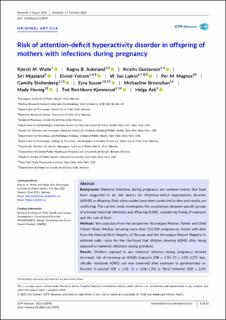| dc.description.abstract | Background
Maternal infections during pregnancy are common events that have been suggested to be risk factors for Attention-deficit hyperactivity disorder (ADHD) in offspring. Only a few studies have been conducted to date and results are conflicting. The current study investigates the associations between specific groups of prenatal maternal infections and offspring ADHD, considering timing of exposure and the role of fever.
Methods
We used data from the prospective Norwegian Mother, Father and Child Cohort Study (MoBa), including more than 112,000 pregnancies, linked with data from the Medical Birth Registry of Norway and the Norwegian Patient Registry to estimate odds ratios for the likelihood that children develop ADHD after being exposed to maternal infections during gestation.
Results
Children exposed to any maternal infection during pregnancy showed increased risk of receiving an ADHD diagnosis (OR = 1.15, CI = 1.03–1.27). Specifically, increased ADHD risk was observed after exposure to genitourinary infections in second (OR = 1.42, CI = 1.06–1.90) or third trimester (OR = 2.04, CI = 1.19–3.49), and to respiratory infections in second trimester (OR = 1.31, CI = 1.12–1.54), provided these infections were accompanied by episodes of fever. Increased ADHD risk was also observed after exposure to diarrhea without fever in the third trimester (OR = 1.25, CI = 1.07–1.46).
Conclusions
Overall, our results suggest that prenatal exposure to maternal infections, particularly with co-occurring episodes of fever, are risk factors for ADHD. Fever (or severity of the infection) appears to be more important in mid-pregnancy associations. Our results indicate that type of infection and timing of exposure might influence the associations, but small effect sizes require careful interpretations. The association between infection and ADHD should be estimated using discordant siblings or other negative control designs that give better adjustment for unmeasured familial confounding. | en_US |

